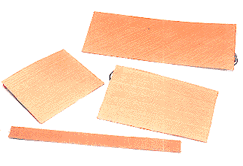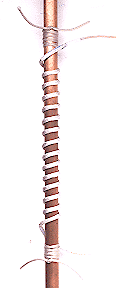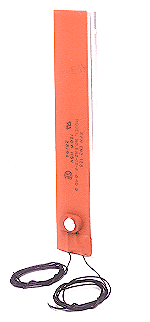|
Electric
Heater Related

Applications
Guide
Silicone Rubber/Fiberglass and Kapton Insulated Flexible Heaters: Flexible heating
elements have a wide range of industrial, commercial, and military applications
where reliability, cost effectiveness, minimum cross-section, resistance to
deterioration, and basic flexibility are critical.
Silicone Rubber/Fiberglass
Heaters (see figures 1-2) are the most widely used flexible heaters. Temperature
rated from -70°F to +450°F, silicone rubber resists radiation, moisture, compression
set, weathering, vacuum, fungus, oils, solvents, and chemical attack. It may
be factory bonded or applied with silicone rubber RTV cement or pressure sensitive
adhesive systems. Various mechanical fastenings are also available.
 Kapton/FEP
Film Insulation (see figue2) is ideal for very precise heating requirements
such as satellites and aerospace equipment. Kapton, used from -328°F to +392°F,
is self-extinguishing, has double the tensile strength of fiberglass reinforced
silicone rubber, and is not affected by common solvents and fluids. Kapton is
almost 50% lighter than silicone rubber insulation and provides a 0.010" maximum
cross-section. Kapton/FEP
Film Insulation (see figue2) is ideal for very precise heating requirements
such as satellites and aerospace equipment. Kapton, used from -328°F to +392°F,
is self-extinguishing, has double the tensile strength of fiberglass reinforced
silicone rubber, and is not affected by common solvents and fluids. Kapton is
almost 50% lighter than silicone rubber insulation and provides a 0.010" maximum
cross-section.
Temperature Control:
In the majority of applications for silicone rubber and Kapton insulated heaters,
some form of temperature control must be used. See Section P for temperature
controls. In some applications, electromechanical thermostats or other types
of temperature control may be used. (See figures 3 and 4)
 Custom
Engineered Heaters: Flexible heaters can be custom made to meet your requirements
for size, voltage and wattage. Built-in thermostats can also be provided on
request. For more information, contact our engineering department. The following
information may be helpful in determining precise heater requirements. To determine
wattage requirement see Section Z.Specific Heats And Densities Of Common Heat
Sink MaterialsComparison Of Materials Custom
Engineered Heaters: Flexible heaters can be custom made to meet your requirements
for size, voltage and wattage. Built-in thermostats can also be provided on
request. For more information, contact our engineering department. The following
information may be helpful in determining precise heater requirements. To determine
wattage requirement see Section Z.Specific Heats And Densities Of Common Heat
Sink MaterialsComparison Of Materials
| |
Specific
Density |
| Material |
Heat*
(lbs/cu in) |
| Aluminum
& Its Alloys |
0.23
 0.1018 0.1018
|
| Stainless
Steels |
0.12 0.2895
0.2895 |
| Carbon
Steels |
0.11
 0.2827 0.2827
|
| Copper
Alloys |
0.10 0.3231
0.3231 |
| Nickel
& Its Alloys |
0.10
 0.3340 0.3340 |
| Zinc
& Its Alloys |
0.10 0.2589
0.2589 |
 *Btu/lb7F
for cal/gm7CThe temperature shown is the internal metallic element temperature.
This would be the hottest point of the heater. The test heater was suspended
horizontally in still air at a 70°F ambient temperature. *Btu/lb7F
for cal/gm7CThe temperature shown is the internal metallic element temperature.
This would be the hottest point of the heater. The test heater was suspended
horizontally in still air at a 70°F ambient temperature.
Watt densities
of up to 35 watts/in2 are possible when heaters are bonded to a heat sink and
controlled with a thermostat or electronic control. This test is based on a
bond strength test of samples of silicone rubber/fiberglass bonded to aluminum
or stainless steel. The time required for bond strength to deteriorate to less
than 2 pounds per inch of width of heater was considered the end point of the
material.
| 






